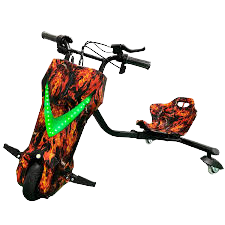Introduction
Drifting, a thrilling driving technique that involves controlled slides around corners, has become a phenomenon in the automotive world. Enthusiasts and adrenaline-seekers alike have embraced this unique skill, making drifting a popular motorsport and recreational activity. Whether you’re new to drifting or looking to enhance your technique, this article will provide essential tips to help you perfect the art of drifting.
Understanding Drifting: What It is and How It Works
At its core, drifting is the art of intentionally oversteering a car, causing the rear tires to lose traction while maintaining control of the vehicle. Skilled drifters manipulate their cars to slide sideways around corners, creating a breathtaking display of car control and precision.
The Thrill of Drifting: Why It’s So Popular
The allure of drifting lies in its excitement and showmanship. Drifters push their vehicles to the limit, performing spectacular slides and maneuvers that captivate audiences and fellow enthusiasts. The adrenaline rush and the skillful execution of controlled chaos make drifting a thrilling and addictive activity.
The Basics of Drifting: A Closer Look at the Technique
What is Drifting?
Drifting involves maintaining a controlled slide through a corner while keeping the vehicle stable and on track. The artistry of drifting lies in balancing the car’s speed, angle, and direction throughout the maneuver.
Types of Drifting
Drifting encompasses various styles, including the classic “feint drift,” “power slide,” and “brake drift.” Each style requires different techniques and approaches to achieve the desired effect.
Key Elements of Drifting
To execute a successful drift, drivers must understand the critical components of drifting, such as weight transfer, steering, and throttle control.
Choosing the Right Vehicle for Drifting
Rear-Wheel-Drive vs. All-Wheel-Drive
Rear-wheel-drive (RWD) vehicles are the preferred choice for drifting, as they provide a more natural balance and allow for smoother slides. However, all-wheel-drive (AWD) cars can also drift, albeit with different techniques and challenges.
Manual vs. Automatic Transmission
Manual transmissions offer more control over gear changes, making them the preferred choice for many drifters. Nevertheless, some skilled drifters can also achieve impressive slides with automatic transmissions.
Modifying Your Car for Drifting
While drifting can be done with a stock car, modifying your vehicle can significantly enhance its drifting capabilities. Common modifications include suspension upgrades, limited-slip differentials, and performance tires.
Mastering the Drift: Step-by-Step Guide
The Clutch Kick Technique
The clutch kick is a fundamental drifting technique that involves a sudden release of the clutch to induce oversteer. Proper timing and throttle control are crucial to execute this maneuver effectively.
Counter-Steering and Angle Control
Counter-steering is the art of turning the wheels in the opposite direction of the drift to maintain control and prevent spinning out. Angle control allows drifters to adjust the drift’s angle and trajectory.
Weight Transfer and Balance
Understanding weight transfer is essential for initiating and maintaining a drift. Shifting the car’s weight strategically enables smoother and more controlled slides.
Drifting on Different Surfaces
Safety Precautions: Staying Safe While Drifting
Choosing the Right Location
Drifting should only be practiced in controlled environments, such as closed circuits or designated drifting tracks, to ensure the safety of both drivers and bystanders.
Using Safety Gear
Wearing appropriate safety gear, including helmets, gloves, and racing suits, is essential to protect against potential accidents or collisions.
Practicing Controlled Drifting
Practicing controlled drifting helps minimize the risk of accidents. Drivers should focus on improving technique and gradually pushing their limits in a safe and responsible manner.
Common Mistakes to Avoid
Even experienced drifters make mistakes. Understanding common errors and how to avoid them will contribute to your progress and safety as a drifter.
Perfecting Your Technique: Tips for Improvement
Practice Regularly
Drifting is a skill that requires constant practice to refine and master. Regular practice sessions will help build muscle memory and confidence.
Seeking Professional Guidance
Attending drifting schools or seeking guidance from experienced drifters can provide valuable insights and personalized feedback to improve your drifting technique.
Learning from Experienced Drifters
Learning from experienced drifters and engaging in the drifting community allows you to exchange knowledge, tips, and experiences to enhance your skills.
The Drifting Community: Joining the Culture
Drifting Events and Competitions
Participating in drifting events and competitions not only allows you to showcase your drifting skills but also provides an opportunity to bond with fellow enthusiasts.
Online Drifting Communities
Joining online drifting communities connects you with like-minded individuals, fostering a sense of camaraderie and a platform to share experiences and knowledge.
Building Connections in the Drifting World
Networking with other drifters and enthusiasts can open doors to new opportunities, such as collaborative projects, sponsorships, and access to exclusive events.
Conclusion
Drifting is an exhilarating art that demands skill, finesse, and practice. With the right vehicle, technique, and safety precautions, you can master the art of drifting and experience the thrill of controlled slides around corners. Embrace the drifting culture, connect with fellow enthusiasts, and continuously seek to improve your skills to become a true master drifter.
FAQs
- Is drifting dangerous?
- Drifting can be dangerous if not practiced in controlled environments with proper safety precautions. Always wear safety gear and avoid drifting on public roads.
- Can any car be used for drifting?
- While rear-wheel-drive cars are best suited for drifting, with the right modifications, some front-wheel-drive and all-wheel-drive cars can also drift.
- Do I need special tires for drifting?
- Yes, performance tires with low traction and good lateral grip are ideal for drifting. These tires allow for controlled slides while maintaining stability.
- How long does it take to learn drifting?
- The time it takes to become proficient at drifting varies for each individual. Regular practice and dedication are key to mastering this skill.
- Is drifting a recognized motorsport?
- Yes, drifting has gained recognition as a motorsport and is now organized in various professional and amateur competitions worldwide.
